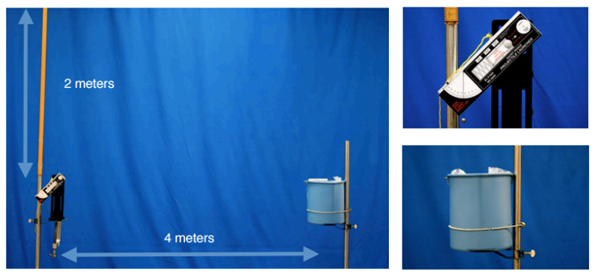Kinematics and Projectile Motion
Overview
Source: Ketron Mitchell-Wynne, PhD, Asantha Cooray, PhD, Department of Physics & Astronomy, School of Physical Sciences, University of California, Irvine, CA
This experiment demonstrates the kinematics of motion in 1 and 2 dimensions. This lab will begin by studying motion in 1 dimension, under constant acceleration, by launching a projectile directly upward and measuring the maximum height reached. This lab will verify that the maximum height reached is consistent with the kinematic equations derived below.
Motion in 2 dimensions will be demonstrated by launching the ball at an angle θ. Using the kinematic equations below, one can predict the distance to where the projectile will land based upon the initial speed, total time, and angle of trajectory. This will demonstrate kinematic motion with and with out acceleration in the y- and x-directions, respectively.
Procedure
1. Motion in 1 dimension.
- Obtain a ball, a launcher with a plunger, two poles, a bucket, two clamps, a bungee cord, and a 2-m stick.
- Attach the launcher to a pole, with a 2-m length of pole above it.
- Use the plunger to place the ball in the launcher at maximum spring tension.
- Angle the launcher directly upwards so θ = 0.
- Launch the ball and use a stopwatch to measure the total time t it takes the ball to reach its maximum height. The init
Results
Representative results from steps 1 and 2 of the above procedure are listed below in Table 1. This table records the maximum height the ball reached in both 1 and 2 dimensions, with a known initial velocity and total flight time. The value of the experimentally measured maximum vertical displacement is compared to that calculated using Equation 15, the value of which is also found below. The table also records the maximum horizontal displacement of the ba
Application and Summary
Kinematics is used in a wide range of applications. The military uses these kinematic equations to determine the best way to launch ballistics. For better accuracy, the drag of air resistance is included in the equations. Car manufactures use kinematics to figure out top speeds and stopping distances. In order to take off,airplanes must attain a certain speed before they run out of runway. With kinematics,it is possible compute how fast the pilot will need to accelerate when taking off at a certain airport.
Tags
Skip to...
Videos from this collection:

Now Playing
Kinematics and Projectile Motion
Physics I
72.7K Views

Newton's Laws of Motion
Physics I
76.0K Views

Force and Acceleration
Physics I
79.2K Views

Vectors in Multiple Directions
Physics I
182.4K Views

Newton's Law of Universal Gravitation
Physics I
191.5K Views

Conservation of Momentum
Physics I
43.4K Views

Friction
Physics I
52.9K Views

Hooke's Law and Simple Harmonic Motion
Physics I
61.4K Views

Equilibrium and Free-body Diagrams
Physics I
37.4K Views

Torque
Physics I
24.9K Views

Rotational Inertia
Physics I
43.5K Views

Angular Momentum
Physics I
36.3K Views

Energy and Work
Physics I
50.0K Views

Enthalpy
Physics I
60.4K Views

Entropy
Physics I
17.7K Views
Copyright © 2025 MyJoVE Corporation. All rights reserved
